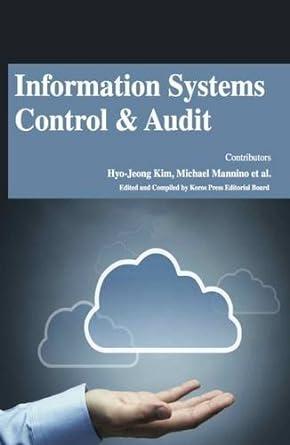Question
20. Financial leverage increases with A) high total cost. B) high variable cost in relation to total cost. C) high fixed cost in relation to
20. Financial leverage increases with
A) high total cost.
B) high variable cost in relation to total cost.
C) high fixed cost in relation to total cost.
D) high debt in relation to stockholders equity.
E) high sales in relation to assets.
26. From the standpoint of user agreement with the result of a cost allocation, the most difficult basis to use for cost allocation is:
A) cost accounting standards
B) cause and effect
C) ability to bear
D) benefits received
E) fairness
29. Overhead costs are allocated to product cost objects in an activity-based cost system in the following manner:
A) overhead costs are assigned to departments, then costs are assigned to products.
B) overhead costs are assigned to activities, then costs are assigned to departments before assigning to products.
C) overhead costs are assigned to activities, then costs are assigned to products.
D) overhead costs are traced directly to products making assigning them unnecessary.
E) none of the above.
32. Which one of the following is a true statement about activity-based costing?
A) There is generally one and only one cost driver for each activity.
B) The activity driver (used to assign the overhead to the cost objects) must be a cost driver.
C) There is no such thing as a resource driver.
D) Process mapping is a good way to identify activities for activity-based costing.
E) Every activity-based costing system will have the same activities, as long as the companies are in the same industry.
33. The master budget process usually begins with the:
A) production budget.
B) selling and administrative expense budget.
C) sales budget.
D) cash budget.
Chicken Nuggets, LLC, provides chicken nuggets to fast food restaurants. The standard cost card for chicken nuggets indicates each nugget takes two ounces of chicken meat at $0.03 per ounce, 30 seconds of direct labor at $12.00 per hour, and 30 seconds of overhead at $6.00 per hour, for a total standard cost of $0.21 per nugget. Current production cost for 200,000 nuggets show material cost of $11,024 for 440,960 ounces of chicken at $0.025 per ounce; $19,380 for 1,675 hours of direct labor at $11.57 per hour; and $10,050 of overhead applied for 1,675 hours at $6.00 per hour.
Legend: U = Unfavorable F = Favorable (Include U or F, after the amount)
36. (10) The direct material quantity (usage) variance is calculated to be _____U___?
37. (10) The direct labor efficiency variance is calculated to be ________?
38. (10) The direct labor rate variance is calculated to be ________?
39. A cost that is often overlooked, because it is not recorded on the books, is called a (an):
A) sunk cost
B) fixed cost
C) missing cost
D) opportunity cost
E) variable cost
. In the theory of constraints, throughput is defined as:
A) total manufacturing costs.
B) sales less direct labor costs.
C) sales less direct material costs.
D) sales less direct labor and material costs.
E) sales less processing costs.
.
47. Which one of the following is not one of the five steps in TOC analysis?
A) Identify the binding constraint(s).
B) Determine the most efficient utilization for each binding constraint.
C) Manage the flow through the binding constraint.
D) Deduct capacity from the binding constraint.
E) Redesign the manufacturing process for flexibility and fast throughput.
48. A system for balancing the flow of production through a binding constraint, thereby reducing the amount of inventory at the constraint and improving overall productivity is a:
A) Drum-buffer-rope system.
B) Just-in-time system.
C) Theory of constraints system.
D) Activity based costing system.
E) Total quality management system.
50 and 51 use the following information:
TEB, Inc., which manufactures video games, consists of two divisions, each operating as a profit center. Division A makes a component that is needed by Division B; however, if the price from Division A is too high, Division B has indicated it would purchase the component from an outside supplier. Additional information related to the divisions is:
Division Bs annual needs for component 10,000 units
Division As capacity 40,000 units
Division As current sales at $170 per unit 30,000 units
Division As total cost per unit ($140 variable and $10 fixed) $150
Division As annual fixed cost $1,500,000
Price per unit to buy from outside supplier $160
Assume Division A has an offer from a foreign buyer to purchase 10,000 units at $150 per unit. Assume the company management (Vice-President above the two divisions) wants Division A to supply/transfer 10,000 units to Division B.
50. The most logical minimum acceptable transfer price is __________?
51. The most logical maximum acceptable transfer price is __________?
Step by Step Solution
There are 3 Steps involved in it
Step: 1

Get Instant Access to Expert-Tailored Solutions
See step-by-step solutions with expert insights and AI powered tools for academic success
Step: 2

Step: 3

Ace Your Homework with AI
Get the answers you need in no time with our AI-driven, step-by-step assistance
Get Started


